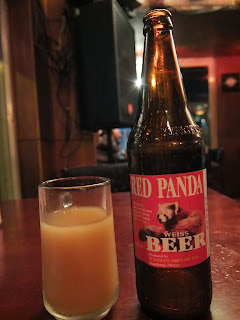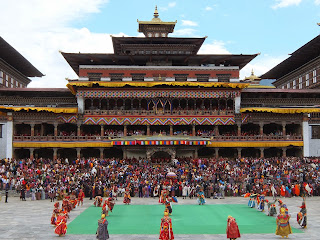Bhutan and Finland, part 1: Alcohol
Bhutanese people often ask how do I like Bhutan, adding that "it must be very different from your country".
Actually, in many ways, it isn't.
Just to name a few common things between Finland and Bhutan:
- Forest coverage in Finland: 78 %, in Bhutan: 72 %
- People are modest and don't like bragging about themselves
- Showing emotions is not common, and talking about them is even less common
- And finally, alcohol consumption is high (highest in South Asia), and the people who drink, drink a lot
 |
| Local Red Panda weissbier. Only local beer brands are allowed to be sold in most restaurants to boost domestic brewery industry. |
The attitude towards drunk-driving is still a bit shocking for me here: so far I have met no-one who would NOT drive after drinking. Luckily roads are very curvy, hilly and have a lot of potholes, forcing people to drive slowly and potential accidents are not as bad as they could be on a high-speed motorway. This is what I hope, at least...
Statistically Finland does much worse in terms of alcohol consumption when compared to Bhutan. Alcohol is the number one cause of death among the 15-64 year-olds in Finland, and the amount of drank alcohol has tripled from 1968 to 2008. WHO statistics for Bhutan claim that the total alcohol consumption in Bhutan (2003-2005) would only be 0,5 litres of pure alcohol per person (which sounds very low) - for Finland, the same figure is 12,5 litres!
Problem-drinking does not seem to be a taboo topic in Bhutan.
An excellent Bhutanese blogger Riku Dhan Subba posted telling photos of passed-out people on the streets of Thimphu. Public broadcasting service BBS covered alcohol abuse in a news article from different angles (domestic violence, drunk-driving, health issues), noting that "Bhutan is the only country where alcohol and sport goes together" (see previous post on archery).
A week ago in a lifeskills training for out-of-school unemployed youth, organized by the Ministry of Education, a group of youth made a role play on the topic of alcoholism. They were probably as giggly about it as Finnish youth would have been, but the discussion afterwards was still heartfelt. Perhaps it is only my bad memory, but I can't recall any proper discussion on alcohol from my school days while I do remember many, many talks and presentations on drugs. It is hard to have a serious discussion about alcohol in Finland without either becoming immediately moralizing or turning it into a joke (article about history of alcohol, in Finnish).
 |
| Photo from Thimphu tsechu, religious festival where no drinking was seen. |
Another major
difference between Finland and Bhutan is the
relation of alcohol to religion. The Statistical Bureau in Finland would
probably not start their publication on alcohol use with social, cultural and religious meanings attached to alcohol, as the National Statistics Bureau in Bhutan does in "Alcohol use and abuse in Bhutan" (2012, pdf). According to this publication, Mahayana Buddhism regards chang (alcohol
in Dzongkha) as "eternal nectar" which is used in tantric rituals along
with meat. Meat offering is seen as symbolic of "skillful means" and
alcohol as symbolic of "wisdom", "the luminous lamp of wakefulness".
Deep stuff.
This
very elaborate list of different concepts on alcohol use in Bhutan is
taken from the section on "Social, cultural and economic significance of
alcohol" in the same publication:
Serkem chang Drink
offerings to local deities
Tor chang Drinks
furnished while making ritual cakes
Deutsi chang
Spiritual offertory drinks
Sangdze chang
Alcohol used as an ingredient of incense offering
Jinsek chang Used
as an ingredient for warding off evils rituals
Yang chang Brewed
for the god of wealth
Ngo chang Drink
offerings for the sake of the dead
Tsan chang Drink
offerings to local deity
Tshe chang Drinks
brewed for long life rituals
Khando chang Ritual
drinks related to individual astrology
Tshog chang
Communal tradition of offering drinks to visitors (popular in east)
Duen chang Drinks
to welcome guests (pastoral societies)
Tengkor chang
Drinking for reciprocity
Tsug chang Drinks
to begin any important work
Bar chang Drinks
served in the middle of work
To chang Drinks
served before meals
Zhe chang Drinks
served after meals
Branpa chang
Drinks for free labour services (eastern Bhutan)
Nar chang Drinks
to request labour help (eastern Bhutan)
Suwa chang Usually
reception drinks
Dong chang Arrival
drinks
Log chang
Reciprocal drinks
Zim chang Night
dose
Zheng chang
Wake-up drinks
Lam chang Journey
drinks
I can't make any kind of list of similar Finnish vocabulary on alcohol for different drinking circumstances, besides "alkumalja" (starting drink in festivities) or "ehtoollisviini" (sacramental wine). Help, anyone?
 |
| Group of monks at the Dzong in Thimphu, the seat of both political and religious powers. |
Comments